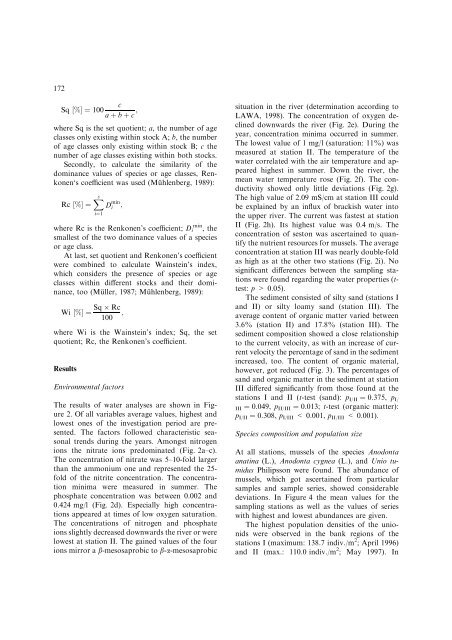Population size and structure of three mussel species (Bivalvia ...
Population size and structure of three mussel species (Bivalvia ...
Population size and structure of three mussel species (Bivalvia ...
Create successful ePaper yourself
Turn your PDF publications into a flip-book with our unique Google optimized e-Paper software.
172<br />
c<br />
Sq ½%Š ¼100<br />
a þ b þ c ;<br />
where Sq is the set quotient; a, the number <strong>of</strong> age<br />
classes only existing within stock A; b, the number<br />
<strong>of</strong> age classes only existing within stock B; c the<br />
number <strong>of</strong> age classes existing within both stocks.<br />
Secondly, to calculate the similarity <strong>of</strong> the<br />
dominance values <strong>of</strong> <strong>species</strong> or age classes, Renkonen‘s<br />
coefficient was used (Mu¨ hlenberg, 1989):<br />
Rc ½%Š ¼ Xs<br />
i¼1<br />
D min<br />
i ;<br />
where Rc is the Renkonen’s coefficient; D i min , the<br />
smallest <strong>of</strong> the two dominance values <strong>of</strong> a <strong>species</strong><br />
or age class.<br />
At last, set quotient <strong>and</strong> Renkonen’s coefficient<br />
were combined to calculate Wainstein’s index,<br />
which considers the presence <strong>of</strong> <strong>species</strong> or age<br />
classes within different stocks <strong>and</strong> their dominance,<br />
too (Mu¨ ller, 1987; Mu¨ hlenberg, 1989):<br />
Sq Rc<br />
Wi ½%Š ¼ ;<br />
100<br />
where Wi is the Wainstein’s index; Sq, the set<br />
quotient; Rc, the Renkonen’s coefficient.<br />
Results<br />
Environmental factors<br />
The results <strong>of</strong> water analyses are shown in Figure<br />
2. Of all variables average values, highest <strong>and</strong><br />
lowest ones <strong>of</strong> the investigation period are presented.<br />
The factors followed characteristic seasonal<br />
trends during the years. Amongst nitrogen<br />
ions the nitrate ions predominated (Fig. 2a–c).<br />
The concentration <strong>of</strong> nitrate was 5–10-fold larger<br />
than the ammonium one <strong>and</strong> represented the 25-<br />
fold <strong>of</strong> the nitrite concentration. The concentration<br />
minima were measured in summer. The<br />
phosphate concentration was between 0.002 <strong>and</strong><br />
0.424 mg/l (Fig. 2d). Especially high concentrations<br />
appeared at times <strong>of</strong> low oxygen saturation.<br />
The concentrations <strong>of</strong> nitrogen <strong>and</strong> phosphate<br />
ions slightly decreased downwards the river or were<br />
lowest at station II. The gained values <strong>of</strong> the four<br />
ions mirror a b-mesosaprobic to b-a-mesosaprobic<br />
situation in the river (determination according to<br />
LAWA, 1998). The concentration <strong>of</strong> oxygen declined<br />
downwards the river (Fig. 2e). During the<br />
year, concentration minima occurred in summer.<br />
The lowest value <strong>of</strong> 1 mg/l (saturation: 11%) was<br />
measured at station II. The temperature <strong>of</strong> the<br />
water correlated with the air temperature <strong>and</strong> appeared<br />
highest in summer. Down the river, the<br />
mean water temperature rose (Fig. 2f). The conductivity<br />
showed only little deviations (Fig. 2g).<br />
The high value <strong>of</strong> 2.09 mS/cm at station III could<br />
be explained by an influx <strong>of</strong> brackish water into<br />
the upper river. The current was fastest at station<br />
II (Fig. 2h). Its highest value was 0.4 m/s. The<br />
concentration <strong>of</strong> seston was ascertained to quantify<br />
the nutrient resources for <strong>mussel</strong>s. The average<br />
concentration at station III was nearly double-fold<br />
as high as at the other two stations (Fig. 2i). No<br />
significant differences between the sampling stations<br />
were found regarding the water properties (ttest:<br />
p > 0.05).<br />
The sediment consisted <strong>of</strong> silty s<strong>and</strong> (stations I<br />
<strong>and</strong> II) or silty loamy s<strong>and</strong> (station III). The<br />
average content <strong>of</strong> organic matter varied between<br />
3.6% (station II) <strong>and</strong> 17.8% (station III). The<br />
sediment composition showed a close relationship<br />
to the current velocity, as with an increase <strong>of</strong> current<br />
velocity the percentage <strong>of</strong> s<strong>and</strong> in the sediment<br />
increased, too. The content <strong>of</strong> organic material,<br />
however, got reduced (Fig. 3). The percentages <strong>of</strong><br />
s<strong>and</strong> <strong>and</strong> organic matter in the sediment at station<br />
III differed significantly from those found at the<br />
stations I <strong>and</strong> II (t-test (s<strong>and</strong>): p I/II ¼ 0.375, p I/<br />
III ¼ 0.049, p II/III ¼ 0.013; t-test (organic matter):<br />
p I/II ¼ 0.308, p I/III < 0.001, p II/III < 0.001).<br />
Species composition <strong>and</strong> population <strong>size</strong><br />
At all stations, <strong>mussel</strong>s <strong>of</strong> the <strong>species</strong> Anodonta<br />
anatina (L.), Anodonta cygnea (L.), <strong>and</strong> Unio tumidus<br />
Philipsson were found. The abundance <strong>of</strong><br />
<strong>mussel</strong>s, which got ascertained from particular<br />
samples <strong>and</strong> sample series, showed considerable<br />
deviations. In Figure 4 the mean values for the<br />
sampling stations as well as the values <strong>of</strong> series<br />
with highest <strong>and</strong> lowest abundances are given.<br />
The highest population densities <strong>of</strong> the unionids<br />
were observed in the bank regions <strong>of</strong> the<br />
stations I (maximum: 138.7 indiv./m 2 ; April 1996)<br />
<strong>and</strong> II (max.: 110.0 indiv./m 2 ; May 1997). In
















